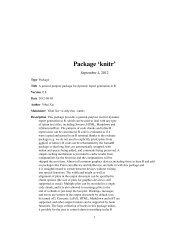Package 'openair'
Package 'openair'
Package 'openair'
Create successful ePaper yourself
Turn your PDF publications into a flip-book with our unique Google optimized e-Paper software.
68 kernelExceedpollutant Mandatory. A pollutant name corresponding to a variable in a data frame shouldbe supplied e.g. pollutant = "nox"typeThe type of analysis to be done. The default is will produce a single plot usingthe entire data. Other types include "hour" (for hour of the day), "weekday" (forday of the week) and "month" (for month of the year), "year" for a polarPlot foreach year. It is also possible to choose type as another variable in the data frame.For example, type = "o3" will plot four kernel exceedance plots for differentlevels of ozone, split into four quantiles (approximately equal numbers of countsin each of the four splits). This offers great flexibility for understanding thevariation of different variables dependent on another. See function cutData forfurther details.byby determines how data above the limit are selected. by = "day" will selectall data (typically hours) on days where the daily mean value is above limit.by = "dayhour" will select only those data above limit on days where thedaily mean value is above limit. by = "hour" will select all data above limit.limitThe threshold above which the pollutant concentration will be considered.data.thresh The data capture threshold to use ( when aggregating the data using timeAverageto daily means. A value of zero means that all available data will be used in aparticular period regardless if of the number of values available. Conversely, avalue of 100 will mean that all data will need to be present for the average to becalculated, else it is recorded as NA.more.than If TRUE data will be selected that are greater than limit. If FALSE data will beselected that less than limit.colsColours to be used for plotting. Options include "default", "increment", "heat","spectral", "hue", "brewer1" and user defined (see manual for more details). Thesame line colour can be set for all pollutant e.g. cols = "black".nbinnumber of bins to be used for the kernel density estimate.auto.text Either TRUE (default) or FALSE. If TRUE titles and axis labels will automaticallytry and format pollutant names and units properly e.g. by subscripting the ‘2’ inNO2.... Other graphical parameters passed onto lattice:levelplot and cutData. Forexample, kernelExceed passes the option hemisphere = "southern" on tocutData to provide southern (rather than default northern) hemisphere handlingof type = "season". Similarly, common axis and title labelling options (suchas xlab, ylab, main) are passed to levelplot via quickText to handle routineformatting.DetailsThe kernelExceed functions is for exploring the conditions under which exceedances of air pollutionlimits occur. Currently it is focused on the daily mean (European) Limit Value for PM10 of50~ug/m3 not to be exceeded on more than 35 days. However, the function is sufficiently flexibleto consider other limits e.g. could be used to explore days where the daily mean are greater than100~ug/m3.By default the function will plot the kernel density estimate of wind speed and wind directions forall days where the concentration of pollutant is greater than limit. Understanding the conditionswhere exceedances occur can help with source identification.
















